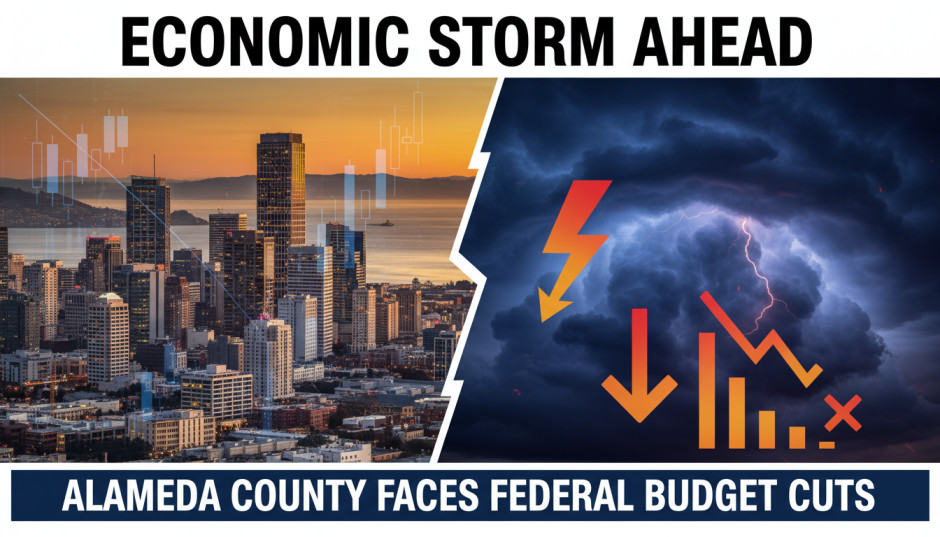Navigating Stormy Waters: Alameda County Faces Economic Uncertainty Amid Federal Budget Concerns

As federal budget cuts loom and political tensions rise, local leaders grapple with maintaining fiscal stability in an increasingly unpredictable landscape
The autumn air in Alameda County carries more than just the scent of changing seasons—it brings with it an atmosphere of economic uncertainty that has local officials, business leaders, and residents alike watching the horizon with cautious eyes. Recent developments from the county’s Economic Forecast symposium have painted a picture of cautious optimism tempered by very real concerns about what lies ahead.
The Warning Signs Are Clear
At the heart of these concerns lies a sobering reality: potential federal budget cuts that could significantly impact local finances across Alameda County. The recent Economic Forecast symposium, attended by key stakeholders from across the region, delivered a message that resonated through conference halls and into city planning offices—the days of predictable federal funding may be numbered.
“We’re looking at a perfect storm of fiscal challenges,” explained one county official who attended the symposium. The warning isn’t just about numbers on a spreadsheet; it’s about real services, real jobs, and real impacts on the nearly 1.7 million residents who call Alameda County home.
The potential cuts could affect everything from transportation infrastructure projects to social services, from educational programs to public safety initiatives. For a county that has historically relied on federal partnerships to fund major initiatives, this represents a fundamental shift in how local government will need to operate.
A Tale of Two Realities
Despite these looming challenges, Alameda County finds itself in what officials describe as a “stable financial position”—at least for now. This apparent contradiction highlights the complex nature of municipal finance in today’s economic climate. While current revenues remain steady and existing programs continue to function, the shadow of future uncertainty looms large over budget planning sessions.
The stability stems from several factors: a diverse economic base that includes everything from tech companies in the eastern hills to port operations in Oakland, a relatively robust tax base, and careful financial management over recent years. Property values, while experiencing some volatility, have remained relatively strong compared to other regions, providing a steady stream of property tax revenue.
However, this stability comes with an asterisk. County financial analysts warn that current conditions could change rapidly if federal funding streams dry up or if broader economic conditions deteriorate. The challenge lies in maintaining essential services while building reserves for an uncertain future.
The Ripple Effects of Federal Concerns
Adding another layer of complexity to the economic landscape are growing concerns among Bay Area leaders about federal troop deployment and its potential implications for the region. While the specific details remain fluid, the mere discussion of such measures has created an atmosphere of uncertainty that extends far beyond immediate political considerations.
Local business leaders worry about the potential impact on the region’s reputation as a hub for innovation and international commerce. The Bay Area’s economy has long thrived on its image as an open, welcoming place for global talent and investment. Any perception of instability or federal intervention could have cascading effects on everything from venture capital investment to international trade relationships.
“Uncertainty is the enemy of economic planning,” noted a prominent Oakland business leader. “When companies don’t know what the regulatory or political environment will look like six months from now, they postpone expansion plans, delay hiring, and generally become more conservative in their approach.”
The Human Cost of Fiscal Uncertainty
Behind every budget projection and economic forecast are real people whose lives could be affected by these developments. Alameda County’s social safety net serves hundreds of thousands of residents, from families struggling with housing costs to seniors relying on county health services.
The potential for federal budget cuts raises difficult questions: Which programs would face reductions? How would the county prioritize competing needs? What would happen to the ambitious affordable housing initiatives that have been central to addressing the region’s housing crisis?
County supervisors find themselves in the unenviable position of planning for multiple scenarios, each with its own set of trade-offs and difficult decisions. The challenge is maintaining current service levels while preparing for a potentially very different fiscal reality.
Innovation in the Face of Adversity
Yet, true to the Bay Area’s entrepreneurial spirit, local leaders aren’t simply waiting for federal decisions to determine their fate. Across Alameda County, innovative approaches to fiscal challenges are emerging.
Some cities are exploring new revenue streams, from updated business license structures to creative partnerships with private sector entities. Others are looking at shared services agreements that could reduce costs while maintaining service quality. The county itself is examining ways to streamline operations and eliminate redundancies that have built up over years of growth.
Technology, unsurprisingly, plays a role in many of these solutions. Digital transformation initiatives promise to reduce administrative costs while improving service delivery. Smart city technologies could help optimize everything from traffic flow to energy consumption, potentially generating savings that could offset other budget pressures.
The Regional Response
Alameda County isn’t facing these challenges in isolation. Across the Bay Area, local governments are grappling with similar concerns and exploring collaborative solutions. Regional partnerships that once focused primarily on transportation and environmental issues are now expanding to include economic resilience and fiscal planning.
The Association of Bay Area Governments has convened working groups to examine how regional cooperation could help individual counties weather potential federal funding cuts. These discussions range from shared procurement strategies to coordinated advocacy efforts aimed at protecting crucial federal programs.
Looking Ahead: Preparing for Multiple Futures
As autumn deepens into winter, Alameda County officials are engaged in what one described as “scenario planning on steroids.” Budget workshops that once focused on incremental adjustments are now examining fundamental questions about the role and scope of local government.
The goal isn’t just to survive potential federal cuts, but to emerge stronger and more resilient. This means building financial reserves, diversifying revenue sources, and creating more efficient service delivery models. It also means having honest conversations with residents about what services the county can realistically provide in different funding scenarios.
The Path Forward
While the economic forecast symposium delivered sobering warnings, it also highlighted the county’s fundamental strengths: a diverse economy, innovative leadership, and a community that has repeatedly demonstrated resilience in the face of challenges.
The coming months will test these strengths as never before. Success will require not just sound fiscal management, but also the kind of creative problem-solving and collaborative spirit that has long characterized the Bay Area.
As one county supervisor noted, “We’ve weathered economic storms before—the dot-com crash, the 2008 financial crisis, the pandemic. Each time, we’ve learned something about our capacity to adapt and overcome. This challenge will be no different.”
The question isn’t whether Alameda County will face difficult choices in the months ahead—it almost certainly will. The question is whether local leaders and residents can work together to navigate these challenges while preserving the essential services and quality of life that make the county a place where nearly two million people choose to call home.
In these uncertain times, one thing remains clear: the decisions made in county offices and community meetings over the next few months will shape Alameda County’s future for years to come.









